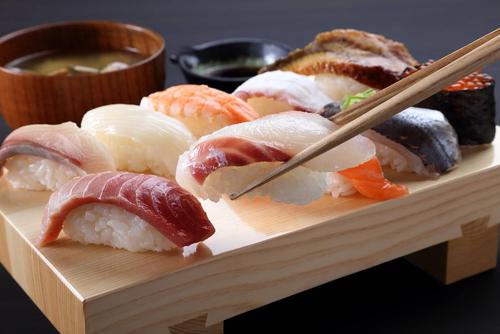Sushi is now synonymous with Japanese culture. With the global boom in Japanese food, the number of Japanese restaurants, including sushi shops, has exceeded 150,000 worldwide. However, even among Japanese people, there are probably not many who fully understand the definition and history of sushi.
This article will provide a general explanation of sushi as part of Japanese culture, including its general definition, types, origins, and etiquette and manners when eating it. We hope you will find this article useful as a source of trivia to help you enjoy sushi more deliciously and with more enjoyment.
Sushi as Japanese culture

First, let's get a grasp of the basics to get a full picture of sushi as a part of Japanese culture.
General definition of sushi and its representative types
First, let me explain the definition of sushi.
Sushi is a Japanese dish that generally combines vinegared rice and toppings (mainly seafood). In addition to fresh seafood, it is not uncommon for the toppings to include meat, vegetables, eggs, and other ingredients.
Furthermore, there are many different types of sushi. California rolls are a good example overseas, but the ingredients and descriptions vary depending on the region and store.
The following types of sushi are popular:
- Nigiri sushi
- sushi rolls
- pressed sushi
- Chirashi sushi
- bar sushi
- Inari sushi
- Hand-rolled sushi
- warship
Three typical ways to write sushi
In addition to the "sushi" used in this article, "sushi" can also be written as "鮓" or "鮨." Let's take a look at the differences and characteristics of each.
- sushi
This is currently the most common way to write it. It originated from an ateji (a Japanese slang expression) created in the Edo period as a lucky charm, and it can be used regardless of the topic or type, so it is widely used.
- sushi
Of the three, "sushi" is the oldest. It originally meant fermented sushi, and inherited the etymology of the word "sushi," which means "sour."
- sushi
This is the second oldest spelling after "sushi." It is often used for Edomae-style sushi, and also refers to the sushi itself.
The history of sushi as Japanese culture

Sushi has a history and culture that spans over a thousand years in Japan. Next, we'll explore the surprisingly little-known origins of sushi.
Sushi originated from a fermented food called narezushi in Southeast Asia.
In fact, sushi originated not in Japan but in Southeast Asia. It is said that sushi originated from a fermented food called "narezushi," which was invented by people living in mountainous regions at the time as a way to preserve fish that was hard to obtain for a long period of time.
In Japan, matured sushi was presented to the Imperial Court as a tribute during the Nara period. Modern pressed sushi and boxed sushi still have traces of that time, but in the Kamakura period, matured sushi using leftover fish began to appear.
Sushi first took on its modern style during the Edo period
In the mid-Edo period, when rice vinegar became commonplace, "haya-zushi" (fast sushi), which did not require fermentation, was born, ushering in an era where sushi could be eaten immediately without waiting.
In the late Edo period, nigiri sushi was invented, but because it was about the size of a rice ball, it was eaten in pieces. The modern style of serving two pieces on one plate is a vestige of that time.
Sashimi began to be used as a topping after the Meiji period.
After the ice industry began to flourish in 1897, along with the development of fishing methods and distribution, sushi restaurants that had previously been unable to serve raw sashimi were able to preserve their ingredients by cooling them in ice.
The common modern-day method of serving sushi by smearing the toppings with boiled soy sauce is a style that was established during this period.
Fast forward to the early Taisho period, when electric refrigerators began to appear in sushi restaurants, and the variety of toppings increased rapidly, while the portions became smaller.
After that, Edomae sushi spread to the countryside as sushi chefs were scattered all over the country due to the effects of the Great Kanto Earthquake.
During the Showa era, sushi restaurants were once considered too expensive, but the emergence of conveyor belt sushi restaurants changed the situation.
Sushi had been steadily developing, but the situation changed dramatically in the Showa era. During the period of rapid economic growth, the previously popular food stalls for sushi were closed down for hygiene reasons.
However, in 1958, the first ever conveyor-belt sushi restaurant opened in Osaka, and sushi once again regained its status as a food for the common people.
Modern sushi, which can be enjoyed at an affordable price, exists as a result of this historical trend.
Etiquette and Manners When Eating Sushi as a Part of Japanese Culture

You can't talk about sushi as a part of Japanese culture without also considering proper etiquette and manners when eating it. It may seem a little formal, but these are like the secrets to enjoying a sushi restaurant, so let's take a look at each point one by one.
Talk to the craftsman
If you visit a sushi restaurant where you can get up close and personal with the sushi chef, be sure to try talking to him. It may seem like a big hurdle, but asking about the day's recommendations and letting him know about your favorite foods and allergies will help you enjoy a more fulfilling meal.
Sushi chefs have an image of being quiet, but surprisingly, many of them love to talk, so why not muster up the courage to give it a try?
Nigiri sushi is eaten with hands, not chopsticks
There are some cultures where eating with your hands is not welcomed, so these days, it is common to see people eating sushi with chopsticks, even in Japan. Of course, how you eat it is a matter of personal preference, but if you don't mind, why not try picking up the sushi and tasting it?
In fact, the sushi that sushi chefs make with all their skill is delicately adjusted to include just the right amount of air so that the sushi melts just right the moment you put it in your mouth.
Therefore, if you accidentally grab the chopsticks with too much force, they will lose their shape and you will miss out on the opportunity to enjoy the special flavor.
Eat nigiri sushi in one bite
In the West, there is the concept of one spoon, and sushi is often seasoned with the expectation that it will be eaten in one bite. Some sushi chefs change the size of their nigiri depending on the customer, such as making smaller portions for women.
Put soy sauce on the toppings, not the rice
In some sushi restaurants where the sushi chef makes the sushi right in front of you, the toppings are often served already coated in sauce. This is to prevent the sushi rice from becoming overly seasoned or losing its shape, which can happen when soy sauce is applied to the rice.
For this reason, it is considered good manners to dip only the toppings in soy sauce at sushi restaurants.
summary
Sushi has a deep history and various etiquette, making it a very complex food. Whether you're eating at a conveyor belt sushi restaurant or a high-end restaurant, remembering and practicing the proper etiquette and manners when eating sushi can help you enjoy it even more.
This article has been partially re-edited by KARUTA from an article originally published on "Nihongo Biyori."
Any unauthorized reproduction or use of the contents, text, images, illustrations, etc. of this website is strictly prohibited.
